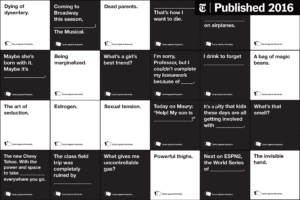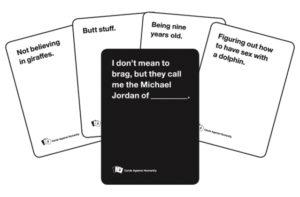 The game I selected for the critical play is Cards Against Humanity. This is a card-game, created by a group of designers consisting of: Josh Dillon, Daniel Dranove, Eli Halpern, Ben Hantoot, David Munk, David Pinsof, Max Temkin, Eliot Weinstein. The target audience of Cards Against Humanity is interestingly enough, 17+, and the game is meant to be played in groups of 3-20+ players. This particular caught my attention after designing our own game, React, as just the thought of having 20 players seems extremely chaotic, and nearly impossible. Card games, in my experience, have always been ideal in groups less than 8, as the task of drawing cards, playing cards, and reading cards can get extremely long, and essentially boring over time. I’ve never played Cards Against Humanity in a group larger than 6 people, so I’m curious about how larger games tend to play out.
The game I selected for the critical play is Cards Against Humanity. This is a card-game, created by a group of designers consisting of: Josh Dillon, Daniel Dranove, Eli Halpern, Ben Hantoot, David Munk, David Pinsof, Max Temkin, Eliot Weinstein. The target audience of Cards Against Humanity is interestingly enough, 17+, and the game is meant to be played in groups of 3-20+ players. This particular caught my attention after designing our own game, React, as just the thought of having 20 players seems extremely chaotic, and nearly impossible. Card games, in my experience, have always been ideal in groups less than 8, as the task of drawing cards, playing cards, and reading cards can get extremely long, and essentially boring over time. I’ve never played Cards Against Humanity in a group larger than 6 people, so I’m curious about how larger games tend to play out.
Beyond the number of players, other formal elements of the game consist of what each player is able to do based on their respective role. Since Cards Against Humanity is one of those games where house rules dominate, I’m going to describe the formal elements in the context of the house rules I’ve always grown up with, as those are which I find most-fun (and it was impossible to convince my friends to play any other way haha). The roles of Cards Against Humanity is split up into a moderator, and the “responders” or the actual people responding to the card drawn. All players will draw 5 cards which describe a particular reaction, then a moderator of that round will draw a context card. The context is read and the remaining players put in their best cards to fill in the context. Based on the cards the players put in, the moderator selects the most funny card, and the player who played that funny card becomes the next moderator for future rounds. The way the rounds work is extremely interesting and really reflects the ability of people to adapt to a lack of structure. Cards Against Humanity is built around subjectivity and there is no set “point system” or structured way to select a winner. It’s all subjective, and the game still somehow works. In that way, repeated rounds of Cards Against Humanity, despite using the same card deck, will never be the same, as they are always dependent on the people playing, rather than the tangible materials.

Example Cards to play & react to
Cards AgainstHumanity uses a fellowship kind of fun to drive gameplay. The entire point of Cards Against Humanity is to laugh, and get closer with other people by understanding their warped sense of humor… or lack of humor. The fellowship fun makes the game extremely risky for any social gathering for various reasons. The most apparent one being sometimes the cards play can be offensive, as thats sometimes the premise of playing. Furthermore, with fellowship fun, fun is almost entirely based on who you are playing with and it can be extremely difficult to find enjoyment in a game if the people you’re playing with don’t connect.

Examples of Reactions to a given context
This game works because of the subjectivity elements to scoring. Had there been a set way to win the game or a distinct rule guide illustrating what are winning cards versus losing cards, the game would lose its replayability. However, due to scoring being completely subjective, the game feels fresh each time. Furthermore, the unstructured aspect of the game actually works in its favor to create an atmosphere which is more social and less based on rule-following, or “playing correctly.” Everytime Cards Against Humanity is played, it feels like a social hangout rather than a game session, which is ideal for fellowship fun
In comparison to other games in this genre, Cards Against Humanity takes a similar approach to Apples to Apples, and instead makes it “adult.” This approach is definetly unique, and I’m uncertain about whether it increases fellowship fun or hinders it as I think the result is greatly dependent on who is playing. The “adult” twist does shift the gameplay from being able to be played with complete strangers, like Apples to Apples, and instead shifts it to be to be made with friend groups instead, in order to minimize the risk of offending someone due to your unfamiliartiy with them. Due to the increased stakes, of the game being possibly offensive at times, people tend to not get as vulnerable, as there is a judgemental atmosphere created through the game mechanics. The game tends to instead stray in just a “casual” environment where people play with the goal to laugh, rather than to foster a closer relationship, or get to know someone better, as its really difficult to get to know someone through the structure of the game revolving around cards alone.



